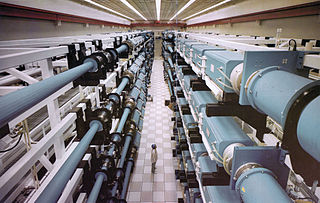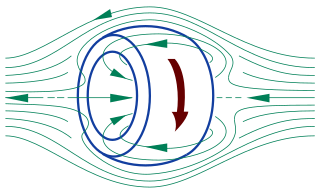Helium-3 is a light, stable isotope of helium with two protons and one neutron. Other than protium, helium-3 is the only stable isotope of any element with more protons than neutrons. Helium-3 was discovered in 1939.

Nuclear fusion is a reaction in which two or more atomic nuclei, usually deuterium and tritium, combine to form one or more different atomic nuclei and subatomic particles. The difference in mass between the reactants and products is manifested as either the release or absorption of energy. This difference in mass arises due to the difference in nuclear binding energy between the atomic nuclei before and after the reaction. Nuclear fusion is the process that powers active or main-sequence stars and other high-magnitude stars, where large amounts of energy are released.

A fusion rocket is a theoretical design for a rocket driven by fusion propulsion that could provide efficient and sustained acceleration in space without the need to carry a large fuel supply. The design requires fusion power technology beyond current capabilities, and much larger and more complex rockets.

Inertial confinement fusion (ICF) is a fusion energy process that initiates nuclear fusion reactions by compressing and heating targets filled with fuel. The targets are small pellets, typically containing deuterium (2H) and tritium (3H).

A fusor is a device that uses an electric field to heat ions to a temperature in which they undergo nuclear fusion. The machine induces a potential difference between two metal cages, inside a vacuum. Positive ions fall down this voltage drop, building up speed. If they collide in the center, they can fuse. This is one kind of an inertial electrostatic confinement device – a branch of fusion research.

Fusion power is a proposed form of power generation that would generate electricity by using heat from nuclear fusion reactions. In a fusion process, two lighter atomic nuclei combine to form a heavier nucleus, while releasing energy. Devices designed to harness this energy are known as fusion reactors. Research into fusion reactors began in the 1940s, but as of 2024, no device has reached net power, although net positive reactions have been achieved.

Nuclear pulse propulsion or external pulsed plasma propulsion is a hypothetical method of spacecraft propulsion that uses nuclear explosions for thrust. It originated as Project Orion with support from DARPA, after a suggestion by Stanislaw Ulam in 1947. Newer designs using inertial confinement fusion have been the baseline for most later designs, including Project Daedalus and Project Longshot.

Neutron generators are neutron source devices which contain compact linear particle accelerators and that produce neutrons by fusing isotopes of hydrogen together. The fusion reactions take place in these devices by accelerating either deuterium, tritium, or a mixture of these two isotopes into a metal hydride target which also contains deuterium, tritium or a mixture of these isotopes. Fusion of deuterium atoms results in the formation of a helium-3 ion and a neutron with a kinetic energy of approximately 2.5 MeV. Fusion of a deuterium and a tritium atom results in the formation of a helium-4 ion and a neutron with a kinetic energy of approximately 14.1 MeV. Neutron generators have applications in medicine, security, and materials analysis.

In fusion power research, the Z-pinch is a type of plasma confinement system that uses an electric current in the plasma to generate a magnetic field that compresses it. These systems were originally referred to simply as pinch or Bennett pinch, but the introduction of the θ-pinch concept led to the need for clearer, more precise terminology.

Aneutronic fusion is any form of fusion power in which very little of the energy released is carried by neutrons. While the lowest-threshold nuclear fusion reactions release up to 80% of their energy in the form of neutrons, aneutronic reactions release energy in the form of charged particles, typically protons or alpha particles. Successful aneutronic fusion would greatly reduce problems associated with neutron radiation such as damaging ionizing radiation, neutron activation, reactor maintenance, and requirements for biological shielding, remote handling and safety.

Magnetic confinement fusion (MCF) is an approach to generate thermonuclear fusion power that uses magnetic fields to confine fusion fuel in the form of a plasma. Magnetic confinement is one of two major branches of controlled fusion research, along with inertial confinement fusion.

A field-reversed configuration (FRC) is a type of plasma device studied as a means of producing nuclear fusion. It confines a plasma on closed magnetic field lines without a central penetration. In an FRC, the plasma has the form of a self-stable torus, similar to a smoke ring.
A dense plasma focus (DPF) is a type of plasma generating system originally developed as a fusion power device starting in the early 1960s. The system demonstrated scaling laws that suggested it would not be useful in the commercial power role, and since the 1980s it has been used primarily as a fusion teaching system, and as a source of neutrons and X-rays.
Magnetized Target Fusion (MTF) is a fusion power concept that combines features of magnetic confinement fusion (MCF) and inertial confinement fusion (ICF). Like the magnetic approach, the fusion fuel is confined at lower density by magnetic fields while it is heated into a plasma. As with the inertial approach, fusion is initiated by rapidly squeezing the target to greatly increase fuel density and temperature. Although the resulting density is far lower than in ICF, it is thought that the combination of longer confinement times and better heat retention will let MTF operate, yet be easier to build. The term magneto-inertial fusion (MIF) is similar, but encompasses a wider variety of arrangements. The two terms are often applied interchangeably to experiments.
General Fusion is a Canadian company based in Vancouver, British Columbia, which is developing a fusion power device based on magnetized target fusion (MTF). The company was founded in 2002 by Dr. Michel Laberge. The company has more than 150 employees in three countries, with additional centers co-located with fusion research laboratories near London, and Oak Ridge, Tennessee, US.

Magnetized liner inertial fusion (MagLIF) is an emerging method of producing controlled nuclear fusion. It is part of the broad category of inertial fusion energy (IFE) systems, which drives the inward movement of fusion fuel, thereby compressing it to reach densities and temperatures where fusion reactions occur. Other IFE experiments use laser drivers to reach these conditions, whereas MagLIF uses a combination of lasers for heating and Z-pinch for compression. A variety of theoretical considerations suggest such a system will reach the required conditions for fusion with a machine of significantly less complexity than the pure-laser approach.
TAE Technologies, formerly Tri Alpha Energy, is an American company based in Foothill Ranch, California developing aneutronic fusion power. The company's design relies on an advanced beam-driven field-reversed configuration (FRC), which combines features from accelerator physics and other fusion concepts in a unique fashion, and is optimized for hydrogen-boron fuel, also known as proton-boron or p-11B. It regularly publishes theoretical and experimental results in academic journals with hundreds of publications and posters at scientific conferences and in a research library hosting these articles on its website. TAE has developed five generations of original fusion platforms with a sixth currently in development. It aims to manufacture a prototype commercial fusion reactor by 2030.

The Linus program was an experimental fusion power project developed by the United States Naval Research Laboratory (NRL) starting in 1971. The goal of the project was to produce a controlled fusion reaction by compressing plasma inside a metal liner. The basic concept is today known as magnetized target fusion.
Colliding beam fusion (CBF), or colliding beam fusion reactor (CBFR), is a class of fusion power concepts that are based on two or more intersecting beams of fusion fuel ions that are independently accelerated to fusion energies using a variety of particle accelerator designs or other means. One of the beams may be replaced by a static target, in which case the approach is termed accelerator based fusion or beam-target fusion, but the physics is the same as colliding beams.

Theta-pinch, or θ-pinch, is a type of fusion power reactor design. The name refers to the configuration of currents used to confine the plasma fuel in the reactor, arranged to run around a cylinder in the direction normally denoted as theta in polar coordinate diagrams. The name was chosen to differentiate it from machines based on the pinch effect that arranged their currents running down the centre of the cylinder; these became known as z-pinch machines, referring to the Z-axis in cartesian coordinates.














